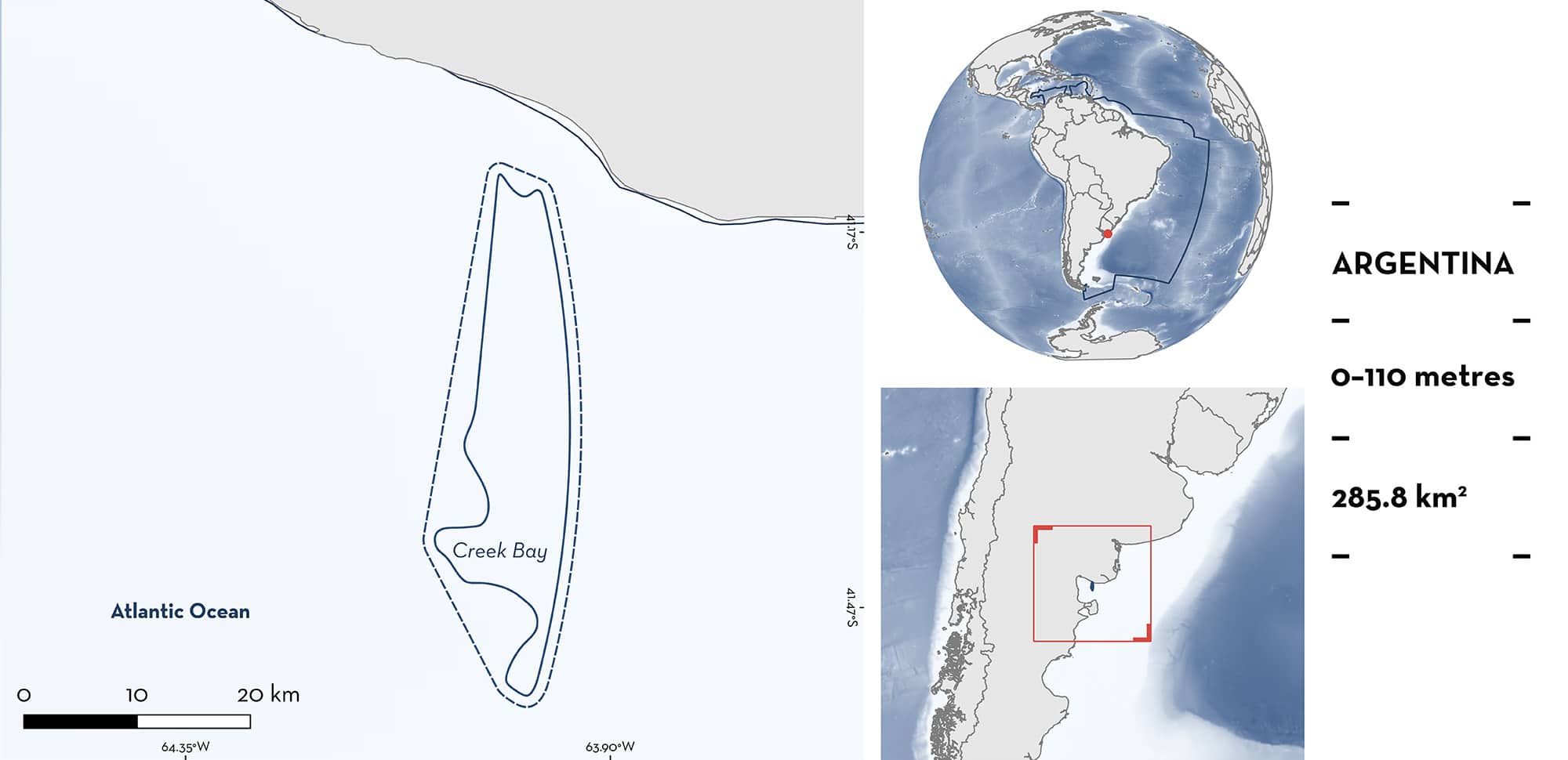ISRA FACTSHEETS
ISRA FACTSHEETS
SOUTH AMERICAN ATLANTIC REGION
Creek Bay
Summary
Creek Bay is located in the Río Negro Province of Argentina. It encompasses the northeast part of the continental shelf in the semi-enclosed San Matías Gulf. The area is influenced by two gyres and a thermohaline front enhanced by tides and regional winds. Within the area there are: threatened species and reproductive areas (American Elephantfish Callorhinchus callorynchus).
Download factsheet
Creek Bay
DESCRIPTION OF HABITAT
Creek Bay is located in the Río Negro Province of Argentina. It encompasses the northeast part of the semi-enclosed San Matías Gulf. This is the second largest gulf in Argentina and covers 19,700 km2 (Gagliardini & Rivas 2004). The area is characterised by continental shelf waters (Coller 2012). It is influenced by two gyres: a cyclonic gyre in the north and an anticyclonic gyre in the south, which drive the inflow of cooler, less saline water from the south and the outflow of warmer, saltier water to the north (Piola & Scasso 1988). From October–March, enhanced by tides and regional winds, a thermohaline front divides the gulf into two areas, with the northern sector having higher salinity and temperature but lower primary productivity (Gagliardini & Rivas 2004).
This Important Shark and Ray Area is benthic and pelagic and is delineated from inshore and surface waters (0 m) to 110 m based on the depth range of Qualifying Species and the bathymetry of the area.
CRITERION A
VULNERABILITY
One Qualifying Species considered threatened with extinction according to the IUCN Red List of Threatened Species regularly occurs in the area. This is the Vulnerable American Elephantfish (Finucci & Cuevas 2020).
CRITERION C
SUB-CRITERION C1 – REPRODUCTIVE AREAS
Creek Bay is an important reproductive area for one chimaera species.
Neonate and young-of-the-year (YOY) American Elephantfish are regularly captured in the area by demersal research trawls (Coller et al. 2023; CONDROS-CIMAS unpubl. data 2025). This region has been recognised as a key habitat for neonates and a pupping ground for the species since the early 1990s (Di Giácomo 1992). During 2016, 2018, 2022, and 2024, standardised bottom trawl surveys were conducted in the Gulf of San Matías during 10–13 days per year, taking place in October, November, or December. Sampling was carried out at 43 stations across the entire San Matías Gulf (CONDROS-CIMAS unpubl. data 2025). A bottom trawl net with a 20.5 m upper headline and an internal codend liner with a mesh size of less than 20 mm was used for 30-minute hauls. Size, sex, maturity stage derived from length, and standard length (SL; measured from the tip of the rostral appendix to the beginning of the upper lobe of the caudal fin) were recorded for each captured individual (Coller et al. 2023).
A total of 877 neonates and YOY were captured in the area, accounting for 75.5% of all individuals in these life stages (n = 1,162) recorded across the entire San Matías Gulf. Neonates and YOY were captured in the area in 2016 (n = 553 individuals), 2018 (n = 194), 2022 (n = 118), and 2024 (n = 12) (Coller et al. 2023; CONDROS-CIMAS unpubl. data 2025). Size ranged from 8–30 cm SL (CONDROS-CIMAS unpubl. data 2025). The size-at-birth for the species is 13 cm total length (which corresponds to ~10.4–11 cm SL; Chierichetti et al. 2017), while maturity is reached between 43–50 cm SL (Finucci & Cuevas 2020). Neonates and YOY were primarily found at depths ranging from 60–106 m in the area (CONDROS-CIMAS unpubl. data 2025).
Download factsheet
SUBMIT A REQUEST
ISRA SPATIAL LAYER REQUEST
To make a request to download the ISRA Layer in either a GIS compatible Shapefile (.shp) or Google Earth compatible Keyhole Markup Language Zipped file (.kmz) please complete the following form. We will review your request and send the download details to you. We will endeavor to send you the requested files as soon as we can. However, please note that this is not an automated process, and before requests are responded to, they undergo internal review and authorization. As such, requests normally take 5–10 working days to process.
Should you have questions about the data or process, please do not hesitate to contact us.


